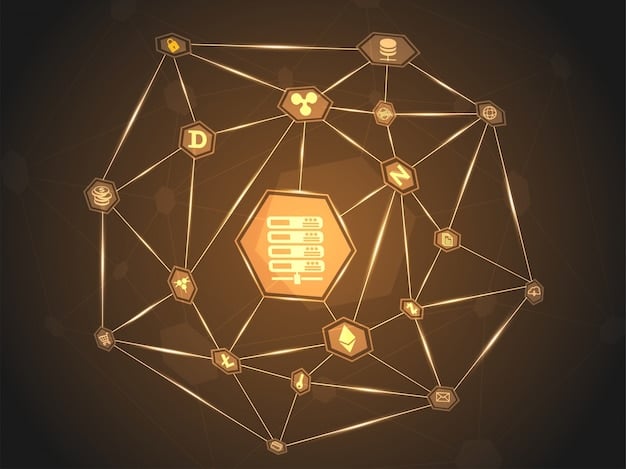Become a Blockchain Expert: Your Guide to Decentralized Tech

Becoming a blockchain expert involves mastering decentralized technologies, understanding cryptographic principles, smart contracts, and various blockchain platforms to innovate across industries like finance, supply chain, and digital identity.
Are you ready to truly become a blockchain expert: the complete guide to understanding and implementing decentralized technologies? In a rapidly evolving digital landscape, blockchain is no longer a niche concept but a foundational technology reshaping global industries. This comprehensive guide is designed to empower you with the knowledge and practical insights needed to navigate this exciting domain.
the fundamentals of blockchain technology
Emerging as a groundbreaking innovation, blockchain technology revolutionizes how data is structured, secured, and transferred across digital networks. At its core, blockchain is a decentralized, distributed ledger that records transactions across many computers, ensuring transparency and immutability. Each “block” in the chain contains a timestamped batch of transactions, and once validated, it’s added to the chain, creating an unchangeable record.
Understanding the underlying principles of blockchain is paramount to grasping its transformative potential. Unlike traditional centralized databases, there is no single point of control, mitigating risks of data manipulation and single points of failure. This distributed nature fosters trust and security among participants who may not inherently trust each other. The technology’s integrity stems from cryptographic hashing, where each new block contains a unique cryptographic hash of the previous one, linking them inextricably.
decentralization and immutability
Decentralization is the cornerstone of blockchain. It means that the network operates without a central authority, distributing control and data across many nodes. This eliminates the need for intermediaries, potentially streamlining processes and reducing costs. Immutability, on the other hand, refers to the inability to alter or delete data once it has been recorded on the blockchain.
- No Single Point of Failure: Data distributed across multiple nodes ensures resilience against outages or malicious attacks.
- Enhanced Trust: Participants can verify transactions without relying on a central intermediary, fostering greater confidence.
- Transparency: All validated transactions are visible to every participant on the network, promoting accountability.
- Security: Cryptographic linking of blocks makes tampering extremely difficult, ensuring data integrity.
consensus mechanisms explained
Consensus mechanisms are protocols that allow all nodes in a decentralized blockchain network to agree on the current state of the ledger. These mechanisms are crucial for maintaining the integrity and security of the blockchain without a central authority. They determine how new blocks are added to the chain and how conflicts are resolved.
The primary types of consensus mechanisms include Proof of Work (PoW), used by Bitcoin and Ethereum (until its transition to Proof of Stake), and Proof of Stake (PoS), now used by Ethereum 2.0. PoW requires participants (miners) to solve complex computational puzzles to validate transactions and add new blocks, consuming significant energy. PoS, in contrast, requires participants (validators) to stake a certain amount of cryptocurrency as collateral to participate in transaction validation, making it more energy-efficient. Other notable mechanisms include Delegated Proof of Stake (DPoS), Proof of Authority (PoA), and many more, each with its own advantages and trade-offs regarding scalability, security, and decentralization. A deep dive into these mechanisms is crucial for anyone aspiring to become a blockchain expert, as their choice significantly impacts a network’s performance and design.
The core idea behind these mechanisms is to prevent malicious actors from dominating the network and to ensure that all participants agree on a single, authoritative version of the transaction history. This agreement is what makes the blockchain secure and trustworthy. Without a robust consensus mechanism, a decentralized ledger would quickly devolve into chaos due to conflicting versions of the truth.
mastering smart contracts and dapps
The true power of blockchain extends beyond digital currency, finding its most innovative applications in smart contracts and Decentralized Applications (dApps). These innovations leverage the immutability and transparency of the blockchain to create self-executing agreements and censorship-resistant software. Mastering these concepts is essential for anyone aiming to become a blockchain expert.
Smart contracts are essentially self-executing contracts with the terms of the agreement directly written into lines of code. They run on a blockchain, meaning they are immutable, transparent, and cannot be tampered with once deployed. When predefined conditions are met, the contract automatically executes, eliminating the need for intermediaries and reducing the potential for disputes. This automation brings unprecedented efficiency and trust to various industries. Consider a real estate transaction: upon the completion of all contractual obligations—like payment and document submission—the smart contract can automatically transfer ownership without a third-party lawyer or broker.
the anatomy of smart contracts
Smart contracts are programmable and can be designed to handle a wide range of functions, from simple escrow services to complex financial derivatives. They typically involve state variables, functions, and events. State variables store data on the blockchain, while functions define the logic and actions that can be performed. Events allow for external applications to react to contract activities, providing a bridge between the blockchain and the outside world. They are highly customizable and can be tailored to suit specific business logic or use cases.
- Automated Execution: Agreements are executed automatically once conditions are met.
- Reduced Intermediation: Eliminates the need for third parties, lowering costs and increasing speed.
- Increased Trust: Code-based execution removes human error or manipulation.
- Transparency: All participants can view the terms and execution of the contract.
developing decentralized applications (dapps)
Decentralized applications (dApps) are software applications built on a decentralized network, like a blockchain. Unlike conventional apps that rely on centralized servers, dApps operate autonomously and cannot be shut down by any single entity. This characteristic makes them highly resilient to censorship and external interference. Their backend code runs on a decentralized peer-to-peer network, such as Ethereum, where smart contracts are a fundamental component.
Developing dApps requires proficiency in specific programming languages, predominantly Solidity for Ethereum-based dApps, but also Vyper, Rust (for Solana), and others depending on the blockchain platform. The development process often involves front-end development using familiar web technologies (HTML, CSS, JavaScript) that interact with the smart contracts on the blockchain. This intersection of traditional web development with blockchain logic creates a powerful suite of applications, from decentralized finance (DeFi) platforms to gaming and digital identity solutions. Understanding the full dApp development lifecycle, including security audits and user experience design for a decentralized environment, is crucial for becoming a successful blockchain expert.
exploring different blockchain platforms
The blockchain ecosystem is diverse, featuring numerous platforms, each with unique characteristics catering to different needs and use cases. To truly become a blockchain expert, one must go beyond merely understanding Bitcoin and Ethereum and delve into the specialized functionalities and communities of other prominent platforms. Each platform embodies different design philosophies regarding scalability, security, decentralization, and governance. The choice of platform significantly impacts the developmental approach, the type of applications that can be built, and the target audience.
Consider the diverse landscape: while Ethereum remains a powerhouse for smart contracts and dApps, offering a robust ecosystem and strong developer support, its scalability challenges led to the emergence of alternative Layer 1 solutions and Layer 2 scaling solutions. Bitcoin, despite being the pioneer, is primarily optimized for peer-to-peer digital cash and has a more rigid, secure, and less programmable blockchain. Exploring these differences is not just an academic exercise; it forms the basis for making informed decisions about which technology suits a particular problem.

ethereum and its ecosystem
Ethereum is arguably the most influential blockchain platform after Bitcoin, known for pioneering smart contract functionality. Its extensibility allows developers to build a vast array of decentralized applications (dApps) and various cryptocurrencies, known as ERC-20 tokens. The transition to Ethereum 2.0 (now called the “Merge” and subsequent upgrades) from Proof of Work to Proof of Stake addressed significant scalability and energy consumption concerns, making the platform more sustainable and efficient.
Projects built on Ethereum span across Decentralized Finance (DeFi), Non-Fungible Tokens (NFTs), gaming, and supply chain management. Understanding the Ethereum Virtual Machine (EVM), gas fees, and its robust tooling (like Truffle and Hardhat) is critical for developers aiming to build on this network. Its extensive documentation and large developer community make it a popular choice for those venturing into blockchain development. The layered architecture of Ethereum, including Layer 2 scaling solutions like Optimism and Arbitrum, offers a blueprint for how complex decentralized systems can evolve to meet global demands.
alternatives and specialized blockchains
Beyond Ethereum, the landscape includes a variety of specialized blockchains, each designed to optimize for certain features or use cases. Solana, for example, is lauded for its high throughput and low transaction costs, making it suitable for high-frequency trading and gaming applications. Polkadot focuses on interoperability, aiming to connect different blockchains and facilitate cross-chain communication, solving the issue of siloed blockchain networks.
Avalanche processes transactions quickly and supports custom blockchains, or subnets, allowing for application-specific networks. Binance Smart Chain (BSC) offers an EVM-compatible environment with lower fees, attracting developers from the Ethereum ecosystem. Cardano, built on peer-reviewed research, emphasizes security and sustainability. Understanding the nuances of these platforms, including their consensus mechanisms, governance models, and developer tools, is essential for a blockchain expert. This diverse array provides developers with choices tailored to specific project requirements, ensuring that the technology used aligns perfectly with the intended application. The ability to compare and contrast these platforms, weighing their pros and cons, is a hallmark of true expertise in this field.
security, privacy, and regulatory landscape
As blockchain technology becomes more integrated into mainstream industries, addressing its security vulnerabilities, ensuring user privacy, and navigating the complex regulatory landscape are paramount. A truly adept blockchain expert must grasp these critical facets, as they heavily influence the design, deployment, and adoption of decentralized solutions. Security on a blockchain isn’t just about preventing hacks; it extends to understanding cryptographic principles, smart contract vulnerabilities, and potential attack vectors on decentralized networks.
Privacy in blockchain is a nuanced subject, balancing the transparent nature of distributed ledgers with the need for individual and transactional anonymity. While public blockchains offer pseudonymous identities, the immutability of recorded transactions raises concerns about long-term privacy and data control. The regulatory environment, still nascent and evolving, presents both opportunities and challenges, requiring careful attention to compliance to ensure the legality and legitimacy of blockchain-based ventures. This interplay of technical safeguards, privacy-enhancing technologies, and legal frameworks forms a crucial pillar of blockchain expertise.
common security vulnerabilities
Despite its inherent security features like immutability and cryptography, blockchain systems are not immune to vulnerabilities, particularly at the application layer. Smart contracts, for instance, can harbor bugs or logical flaws that lead to significant financial losses if exploited (e.g., reentrancy attacks, integer overflow/underflow, timestamp dependence). Beyond smart contracts, issues like 51% attacks on Proof of Work networks, where a single entity controls a majority of the network’s hash rate, can compromise network integrity.
Other concerns include private key management, phishing scams, and vulnerabilities in dApp interfaces. Ensuring robust security involves rigorous code audits, formal verification, multi-signature requirements, and best practices in key management. Developers and users must also be aware of social engineering tactics that target individuals rather than the underlying technology. Continuous monitoring, vulnerability assessments, and swift patch deployments are essential for maintaining the integrity and trustworthiness of blockchain solutions.
- Smart Contract Bugs: Flaws in code that can be exploited for financial gain or system disruption.
- 51% Attacks: A malicious entity gaining control of majority network power to manipulate transactions.
- Private Key Compromise: Loss or theft of private keys leading to unauthorized access to funds.
- Phishing and Social Engineering: Deceptive tactics to trick users into revealing sensitive information.
privacy-preserving techniques
Given that public blockchains inherently offer transparency, protecting user privacy requires specialized techniques. While transactions on public blockchains are pseudonymous (linked to addresses rather than identities), sophisticated analysis can sometimes link addresses to real-world individuals or entities. Privacy-preserving techniques aim to enhance the anonymity and confidentiality of transactions.
Zero-Knowledge Proofs (ZKPs) like zk-SNARKs and zk-STARKs allow one party to prove they know a piece of information without revealing the information itself, enabling private transactions and verifiable computations. Other methods include Confidential Transactions, which hide transaction amounts, and CoinJoin, which mixes multiple users’ transactions to obscure the origins of funds. Privacy coins like Monero also integrate robust privacy features at the protocol level. Understanding these techniques is crucial for developing privacy-centric blockchain solutions and for appreciating the complex trade-offs between transparency, privacy, and regulatory compliance in decentralized systems.
regulatory considerations for blockchain
The regulatory landscape for blockchain technology is incredibly dynamic and varies significantly across jurisdictions. Governments worldwide are grappling with how to classify and regulate cryptocurrencies, decentralized finance (DeFi), NFTs, and other blockchain-based innovations. Key areas of concern include consumer protection, anti-money laundering (AML) and counter-terrorism financing (CTF) compliance, taxation, and securities laws.
For instance, whether a digital asset is considered a security often dictates the regulatory framework it falls under, leading to different compliance requirements. Jurisdictions like the US, EU, and various Asian countries are developing distinct approaches, with some embracing innovation and others adopting a more cautious stance. Staying updated on these global regulatory developments is paramount for any blockchain professional, especially those involved in product development, legal compliance, or investment. Non-compliance can lead to severe penalties, reputational damage, and even legal repercussions. Therefore, integrating legal expertise with technical knowledge is increasingly critical for ethical and sustainable blockchain development.
the future of blockchain and emerging trends
The trajectory of blockchain technology indicates a rapid evolution, moving beyond its initial applications to permeate various sectors, fundamentally altering how we perceive and interact with digital systems. To truly become a blockchain expert, one must not only understand its current capabilities but also possess a keen eye for emerging trends and future potential. The next decade promises transformative changes driven by advancements in scalability, interoperability, and energy efficiency, coupled with broader industry adoption. This forward-looking perspective is crucial for identifying new opportunities and staying ahead in a fast-paced environment.
Consider the potential for widespread adoption: as institutions and enterprises integrate blockchain, new challenges and innovative solutions will emerge, pushing the boundaries of what’s possible. The convergence of blockchain with other frontier technologies like AI, IoT, and big data will unlock unprecedented efficiencies and create novel business models. This continuous innovation underscores the necessity for constant learning and adaptation within the blockchain space.

interoperability and cross-chain solutions
One of the significant challenges in the current blockchain ecosystem is the lack of seamless communication between different blockchain networks. Each blockchain often operates as a self-contained silo, limiting the potential for widespread adoption and complex applications that require data from multiple sources. Interoperability solutions aim to bridge these gaps, enabling different blockchains to exchange information and assets securely and efficiently.
Projects like Polkadot and Cosmos are leading the charge in this area, developing frameworks that allow distinct blockchains (parachains, zones) to connect and communicate. Cross-chain bridges facilitate asset transfers between otherwise incompatible networks, solving liquidity fragmentation issues. These advancements are crucial for a truly decentralized and interconnected digital economy, where assets and data can flow freely across various chains. As blockchain technology matures, interoperability will be a cornerstone for building scalable, versatile, and user-friendly decentralized applications that span multiple ecosystems, making it a critical area of study for any aspiring blockchain expert.
blockchain beyond cryptocurrency: mainstream adoption
While cryptocurrency initially brought blockchain into the public spotlight, the technology’s applications extend far beyond digital money. We are increasingly seeing mainstream adoption of blockchain in various industries, leading to significant shifts in traditional business models. Supply chain management benefits from blockchain’s ability to provide transparent and immutable records of goods, from origin to consumer, enhancing traceability and reducing fraud.
In healthcare, blockchain can secure patient records, facilitate data sharing among providers while maintaining privacy, and streamline drug supply chains to combat counterfeiting. Digital identity solutions leveraging blockchain offer individuals greater control over their personal data, making identity verification more secure and efficient. Real estate transactions, intellectual property rights management, and even voting systems are exploring blockchain for enhanced transparency, security, and efficiency. This broadening scope signifies blockchain’s maturation into a foundational technology, impacting diverse sectors and paving the way for innovative solutions that redefine how industries operate.
the path to becoming a blockchain expert
Embarking on the journey to become a blockchain expert requires a structured approach, blending theoretical knowledge with practical experience. It’s not merely about understanding buzzwords but deeply grasping the underlying computer science, cryptography, and economic principles that govern these decentralized systems. This path demands continuous learning, as the field is dynamic and rapidly evolving. Start with foundational concepts, gradually building up to more complex topics, and crucially, get hands-on with development and analysis. True expertise comes from both comprehension and practical application.
building foundational knowledge
The first step on your journey is to solidify your understanding of core concepts. Begin with the basics: what is a blockchain, how does it work, and what problems does it solve? Dive into cryptography, specifically hashing functions and public-key cryptography, as they are fundamental to blockchain security. Understand the evolution from Bitcoin to Ethereum, grasping the significance of programmable blockchains and smart contracts.
Familiarize yourself with different consensus mechanisms, the distinctions between public, private, and consortium blockchains, and the various network architectures. Online courses, reputable books, and academic papers are invaluable resources at this stage. A strong theoretical foundation will enable you to contextualize new developments and critically analyze the various projects and solutions emerging in the space. Without this bedrock of knowledge, understanding the intricacies of the ecosystem will be challenging.
- Cryptography Basics: Understand hashing and public-key encryption.
- Blockchain Types: Learn about public, private, and consortium blockchains.
- Consensus Mechanisms: Grasp Proof of Work, Proof of Stake, and others.
- Smart Contract Principles: Understand their design, execution, and limitations.
practical skills and development
Once you have a solid theoretical foundation, it’s time to get hands-on. Practical skills are indispensable for a blockchain expert. Start by learning a relevant programming language, with Solidity for Ethereum being a popular choice, but also consider Rust for Solana or WebAssembly for other platforms. Explore development frameworks and tools like Truffle, Hardhat, Brownie, and Ganache, which facilitate smart contract development and testing.
Building small projects, such as a simple ERC-20 token, an NFT contract, or a basic decentralized application (dApp), is crucial for consolidating your knowledge. Participate in hackathons or open-source projects to gain collaborative experience and learn from seasoned developers. Understanding how to deploy smart contracts, interact with blockchain networks through web3 libraries, and perform security audits are critical skills. Beyond coding, gaining proficiency in data analysis for on-chain metrics can provide valuable insights into network health and trends. This practical application transforms theoretical knowledge into actionable expertise.
staying updated in a dynamic field
The blockchain space is characterized by its rapid pace of innovation. To remain a blockchain expert, continuous learning and staying updated are not optional but essential. Follow reputable news sources, academic journals focusing on distributed systems and cryptography, and influential voices in the blockchain community. Participate in online forums, join Discord or Telegram groups of specific projects, and attend webinars or conferences.
Understanding emerging trends like Zero-Knowledge Proofs, Web3 infrastructure, decentralized autonomous organizations (DAOs), and scalability solutions is paramount. Regularly reviewing whitepapers of new projects and protocols can provide early insights into future directions. Networking with other professionals in the field, whether developers, researchers, or business strategists, can offer invaluable perspectives and opportunities. This commitment to lifelong learning ensures that your expertise remains relevant and at the forefront of blockchain advancements.
| Key Point | Brief Description |
|---|---|
| 📚 Foundational Knowledge | Master core concepts: decentralization, cryptography, smart contracts, and consensus mechanisms. |
| 💻 Practical Skills | Learn programming (Solidity), use development tools, and build dApps. |
| 🔒 Security & Privacy | Understand vulnerabilities, privacy techniques, and regulatory compliance. |
| 📈 Future & Trends | Stay current with interoperability, scaling, and mainstream adoption. |
frequently asked questions
A blockchain is a decentralized and distributed ledger that records transactions across many computers, known as nodes. Its security is primarily derived from cryptographic hashing, where each block is linked to the previous one, making it nearly impossible to alter historical data without detection. Additionally, its decentralized nature eliminates single points of failure, enhancing its resilience against attacks and ensuring data integrity through consensus among participants.
Smart contracts are self-executing agreements with the terms directly encoded into lines of blockchain code. They automate execution when predefined conditions are met, eliminating the need for intermediaries. In real-world applications, they enhance efficiency and trust in areas like supply chain management by automating payments upon delivery, real estate by facilitating direct property transfers, and financial services by enabling complex automated agreements without human intervention, reducing costs and delays.
Blockchain achieves decentralization by distributing its ledger across a network of independent computers, or nodes, where each node maintains a copy of the entire ledger. This eliminates the need for a central authority to control or validate transactions. Decentralization is crucial because it ensures transparency, immutability, and censorship resistance, making the system more secure and trustworthy by removing single points of control and failure that characterize traditional centralized systems.
Public blockchains (like Bitcoin or Ethereum) are permissionless, meaning anyone can join the network, participate in consensus, and view all transactions. They prioritize decentralization and transparency. Private blockchains, conversely, are permissioned, restricting participation to a select group of authorized entities. They typically offer higher transaction speeds and more control over data, making them suitable for enterprise applications where privacy and regulatory compliance are paramount, trading some decentralization for efficiency.
Despite its potential, blockchain faces several challenges for widespread adoption. Scalability remains a significant hurdle, as many networks struggle with transaction throughput at mass scale. Regulatory uncertainty across different jurisdictions creates compliance complexities for businesses. Energy consumption of certain consensus mechanisms, like Proof of Work, raises environmental concerns. User experience and interoperability between different blockchain networks also need significant improvement to facilitate smoother integration into existing systems and broader public use.
conclusion
Becoming a blockchain expert in today’s rapidly evolving technological landscape is a journey that demands consistent effort, an insatiable curiosity, and a commitment to continuous learning. From mastering the fundamental concepts of decentralization and cryptography to diving deep into the intricacies of smart contracts, dApp development, and the diverse ecosystem of blockchain platforms, the path is multifaceted. Furthermore, a comprehensive understanding of security vulnerabilities, privacy-preserving techniques, and the dynamic regulatory environment is essential for building robust and responsible blockchain solutions. The insights gained from exploring interoperability and the mainstream adoption of blockchain across various industries underscore that this technology is much more than just cryptocurrencies; it is a foundational shift poised to redefine numerous aspects of our digital future. By embracing both theoretical knowledge and practical application, coupled with a vigilant eye on emerging trends, aspiring blockchain experts can position themselves at the forefront of this transformative field, ready to architect and innovate the decentralized world of tomorrow.





